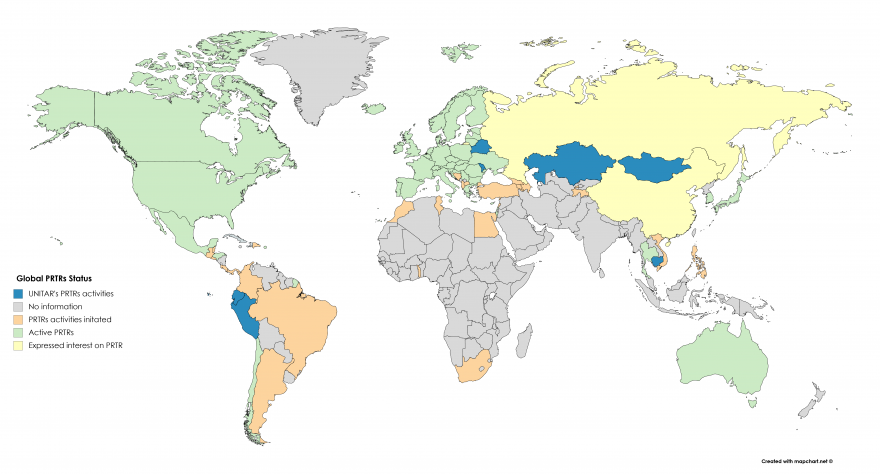TRI Around the World
In 1986, with the enactment of the Emergency Planning and Community Right-to-Know Act (EPCRA), TRI was established as the first national Pollutant Release and Transfer Register (PRTR) in the world. Since then, environmental agencies in other countries have implemented their own PRTR programs modeled after the TRI Program. Currently, at least 50 countries have fully established PRTRs or have implemented pilot programs (see map below). With assistance from international organizations like the United Nations Institute for Training and Research (UNITAR), more countries are expected to develop PRTRs, particularly in Asia, South America, and Africa.

As global PRTR implementation expands, the TRI Program will continue to work with international organizations to:
- Assist in the development of new PRTR programs.
- Promote data standards and core data elements to improve PRTR comparability and harmonization as well as to support global scale analyses.
- Showcase the usefulness of PRTR data for assessing progress towards sustainability.
See the TRI Around the World webpage for more information on the TRI Program’s international partners.
International Project Spotlight: Using PRTR Data to Assess Progress toward the U.N. Sustainable Development Goals
Watch a short video on the report on global PRTRs
Background. The TRI Program collaborates with the Organization for Economic Cooperation and Development (OECD) on PRTR projects, including a project to use global PRTR data to assess progress toward the United Nations’ (U.N.) Sustainable Development Goals (SDGs). These goals are designed to “shift the world on to a sustainable and resilient path” by setting targets that encompass the economic, environmental, and social dimensions of sustainability. As stakeholders work toward the SDGs, the U.N. will measure progress using existing data where possible. Existing data sources for tracking some of the SDGs may include countries’ PRTR data.
Project Focus. The U.N. SDG Target 12.4 was identified as most relevant to PRTR data; it focuses on reducing chemical releases to the environment.
Project Status. OECD published the project report (pdf) (including Spanish (pdf), French (pdf), and Japanese (pdf) versions of the Executive Summary) based on aggregated data for 14 chemicals from multiple countries to assess progress toward achieving SDG Target 12.4. EPA is working with OECD to define the next steps for building on this work. Users can explore the report’s underlying data using the interactive data tool on the OECD PRTR webpage.
Note: PRTRs included in the analyses: Australia – National Pollutant Inventory (NPI), Canada – National Pollutant Release Inventory (NPRI), Chile – Registro de Emisiones y Transferencia de Contaminantes (RETC), European Union – European Pollutant Release and Transfer Register (E-PRTR), Japan Pollutant Release and Transfer Register (PRTR), Mexico – Registro de Emisiones y Transferencia de Contaminantes (RETC), United States – Toxics Release Inventory (TRI). Chemicals included in the analyses: 1,2-Dichloroethane, Benzene, Cadmium, Chromium, Di-(2-ethylhexyl) phthalate, Dichloromethane, Ethylbenzene, Mercury, Nickel, Particulate matter, Styrene, Sulfur oxides, Tetrachloroethylene, Trichloroethylene.
This page was published in March 2024 and uses the 2022 TRI National Analysis dataset made public in TRI Explorer in October 2023.
